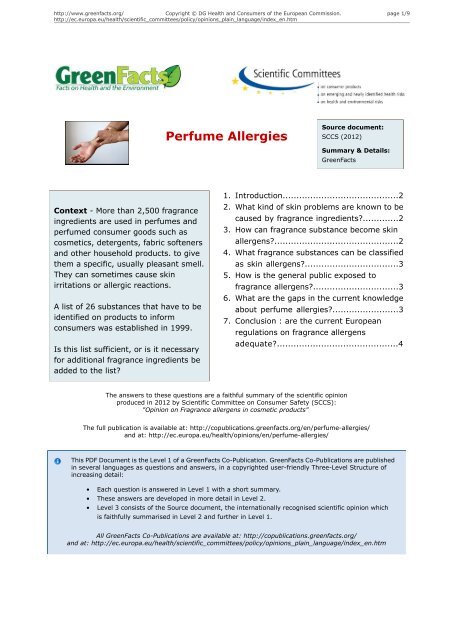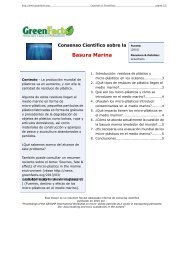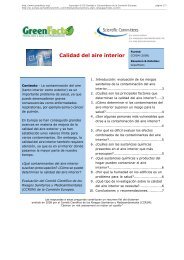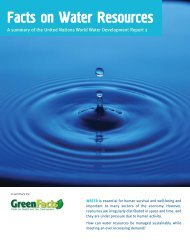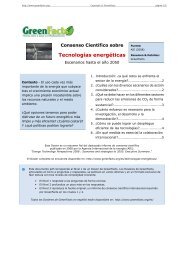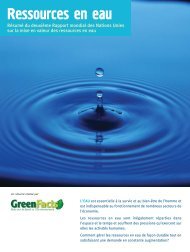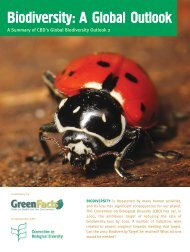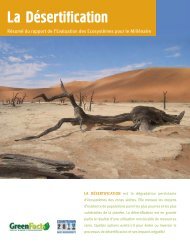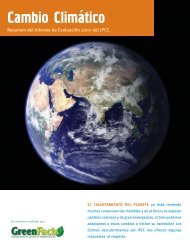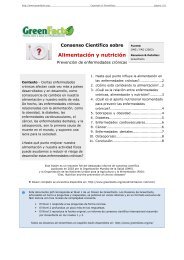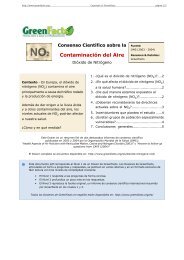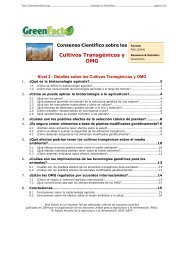Level 1 - EU Projects - Summaries of EC Scientific Assessments
Level 1 - EU Projects - Summaries of EC Scientific Assessments
Level 1 - EU Projects - Summaries of EC Scientific Assessments
You also want an ePaper? Increase the reach of your titles
YUMPU automatically turns print PDFs into web optimized ePapers that Google loves.
http://www.greenfacts.org/<br />
Copyright © DG Health and Consumers <strong>of</strong> the European Commission.<br />
http://ec.europa.eu/health/scientific_committees/policy/opinions_plain_language/index_en.htm<br />
page 1/9<br />
Source document:<br />
Perfume Allergies SCCS (2012)<br />
Summary & Details:<br />
GreenFacts<br />
Context - More than 2,500 fragrance<br />
ingredients are used in perfumes and<br />
perfumed consumer goods such as<br />
cosmetics, detergents, fabric s<strong>of</strong>teners<br />
and other household products. to give<br />
them a specific, usually pleasant smell.<br />
They can sometimes cause skin<br />
irritations or allergic reactions.<br />
A list <strong>of</strong> 26 substances that have to be<br />
identified on products to inform<br />
consumers was established in 1999.<br />
Is this list sufficient, or is it necessary<br />
for additional fragrance ingredients be<br />
added to the list<br />
1.<br />
2.<br />
3.<br />
4.<br />
5.<br />
6.<br />
7.<br />
Introduction..........................................2<br />
What kind <strong>of</strong> skin problems are known to be<br />
caused by fragrance ingredients.............2<br />
How can fragrance substance become skin<br />
allergens.............................................2<br />
What fragrance substances can be classified<br />
as skin allergens..................................3<br />
How is the general public exposed to<br />
fragrance allergens...............................3<br />
What are the gaps in the current knowledge<br />
about perfume allergies........................3<br />
Conclusion : are the current European<br />
regulations on fragrance allergens<br />
adequate............................................4<br />
The answers to these questions are a faithful summary <strong>of</strong> the scientific opinion<br />
produced in 2012 by <strong>Scientific</strong> Committee on Consumer Safety (SCCS):<br />
"Opinion on Fragrance allergens in cosmetic products"<br />
The full publication is available at: http://copublications.greenfacts.org/en/perfume-allergies/<br />
and at: http://ec.europa.eu/health/opinions/en/perfume-allergies/<br />
This PDF Document is the <strong>Level</strong> 1 <strong>of</strong> a GreenFacts Co-Publication. GreenFacts Co-Publications are published<br />
in several languages as questions and answers, in a copyrighted user-friendly Three-<strong>Level</strong> Structure <strong>of</strong><br />
increasing detail:<br />
• Each question is answered in <strong>Level</strong> 1 with a short summary.<br />
• These answers are developed in more detail in <strong>Level</strong> 2.<br />
• <strong>Level</strong> 3 consists <strong>of</strong> the Source document, the internationally recognised scientific opinion which<br />
is faithfully summarised in <strong>Level</strong> 2 and further in <strong>Level</strong> 1.<br />
All GreenFacts Co-Publications are available at: http://copublications.greenfacts.org/<br />
and at: http://ec.europa.eu/health/scientific_committees/policy/opinions_plain_language/index_en.htm
http://www.greenfacts.org/<br />
Copyright © DG Health and Consumers <strong>of</strong> the European Commission.<br />
http://ec.europa.eu/health/scientific_committees/policy/opinions_plain_language/index_en.htm<br />
page 2/9<br />
1. Introduction<br />
Fragrance substances can be derived from natural sources or<br />
chemical synthesis. They are organic compounds with a<br />
characteristic, usually pleasant smell, which are used in perfumes<br />
and perfumed consumer goods such as cosmetics, detergents,<br />
fabric s<strong>of</strong>teners and other household products. Fragrances provide<br />
the consumer with a desired fresh smell or mask unpleasant odours.<br />
Fragrance substances are also used in aromatherapy and are<br />
sometimes present in herbal products.<br />
Fragrance ingredients are<br />
found in cosmetics and<br />
other consumer products.<br />
Source: Lilieks<br />
2. What kind <strong>of</strong> skin problems are known to be caused by fragrance<br />
ingredients<br />
The most common problems observed with fragrance ingredients,<br />
either through use <strong>of</strong> a perfume or a fragranced consumer product,<br />
are skin allergies and skin irritations. Many people complain about<br />
intolerance or rashes to perfumes or perfumed products. However,<br />
the majority <strong>of</strong> complaints commonly described as ‘skin rash’ are<br />
believed to be irritant reactions and not skin allergies. A key<br />
difference is that allergic reactions typically occur with a delay <strong>of</strong><br />
about one day after using the perfume or cosmetic product, while<br />
irritant reactions develop immediately after use.<br />
Skin rashes can be caused<br />
by fragrance ingredients,<br />
but are usually not allergic<br />
reactions.<br />
Source: James Heilman<br />
Skin allergy to fragrance ingredients occurs when an individuals skin has been exposed to<br />
a certain minimum dose <strong>of</strong> a fragrance allergen. For example through regular use <strong>of</strong> a<br />
fragranced cosmetic product. Once an allergy has developed, it is a life-long condition. The<br />
symptoms are redness, swelling and vesicles that are commonly described as ‘skin rash’<br />
and may occur upon re-exposure to the fragrance allergen in question. Skin allergies to<br />
fragrance ingredients are most commonly caused by fragranced cosmetic products and<br />
frequently involve the skin <strong>of</strong> the face, hands or armpits.<br />
Fragrances in perfumes and cosmetic products may also cause irritant reactions. However,<br />
skin irritant reactions cannot necessarily be attributed alone to the fragrance ingredients<br />
contained in the product. This effect also depends on the irritation potential <strong>of</strong> the other<br />
ingredients and their levels in the cosmetic product.<br />
3. How can fragrance substance become skin allergens<br />
To cause a skin allergy, a certain minimum amount <strong>of</strong> the fragrance substance must<br />
penetrate the skin and attach to a skin protein. Only once the fragrance substance is attached<br />
to a skin protein can it provoke a cascade <strong>of</strong> events in our immune system which ultimately<br />
ends in allergy symptoms.<br />
Whilst there are fragrance substances that directly bind to skin proteins, we also know that<br />
there are other types <strong>of</strong> fragrance substances which have to be chemically transformed<br />
before they can bind to skin proteins. This transformation occurs on the skin, for example<br />
in the presence <strong>of</strong> air or sunlight, or under the skin after reacting with skin enzymes<br />
(‘bio-activation’). Such transformation processes may turn a non- or weakly- allergenic<br />
substances into potent skin allergens.
http://www.greenfacts.org/<br />
Copyright © DG Health and Consumers <strong>of</strong> the European Commission.<br />
http://ec.europa.eu/health/scientific_committees/policy/opinions_plain_language/index_en.htm<br />
page 3/9<br />
4. What fragrance substances can be classified as skin allergens<br />
Depending on the quality <strong>of</strong> the available information and the strength <strong>of</strong> the evidence,<br />
dermatologists and other scientists distinguish between established (in humans or animals),<br />
likely, or possible contact allergens. In their evaluations, they consider information available<br />
on the fragrance substance from human studies (for example clinical or epidemiological<br />
studies), data from experimental animal studies or chemical structure information that,<br />
based on historical experience with similar type <strong>of</strong> chemicals, suggest the potential <strong>of</strong> a<br />
fragrance substance to cause skin allergies.<br />
Following their review and data evaluation, the <strong>Scientific</strong> Committee on Consumer Safety<br />
identified a total <strong>of</strong> 54 individual fragrance substances and 28 natural extracts (essential<br />
oils) as ‘established contact allergens in humans’. The scientific committee also considered<br />
18 individual chemicals and 1 natural extract as ‘established contact allergens in animals’,<br />
26 individual chemicals categorised as ‘likely contact allergens’ and 35 individual chemicals<br />
plus 13 natural extracts categorised as ‘possible contact allergens’.<br />
Category<br />
Number <strong>of</strong><br />
individual<br />
fragrences<br />
Number <strong>of</strong><br />
natural extracts<br />
Lists <strong>of</strong> substances<br />
Conclusion concerning labelling <strong>of</strong><br />
consumer products<br />
Established in humans<br />
54<br />
28<br />
82 substances (13.1 [see Annex 2, p. 6]<br />
)<br />
Labelling recommended<br />
(see conclusion)<br />
Established in animals<br />
18<br />
1<br />
19 substances (13.2 [see Annex 1, p. 5]<br />
)<br />
Labelling recommended<br />
(see conclusion)<br />
Likely<br />
26<br />
26 Substances (13.3 [see Annex 4, p. 9]<br />
)<br />
Labelling recommended<br />
(see conclusion)<br />
Possible<br />
35<br />
13<br />
48 substances (13.4 [see Annex 3, p. 8]<br />
)<br />
-<br />
(For the 127 established and likely contact allergens labelling <strong>of</strong> consumer products that<br />
contain them is recommended)<br />
5. How is the general public exposed to fragrance allergens<br />
The general public is exposed to fragrance substances via their use in perfumes and perfumed<br />
consumer products such as cosmetics detergents, fabric s<strong>of</strong>teners and other household<br />
products. In the latter product types, fragrances may be used to provide the consumer with<br />
a fresh smell or to mask unpleasant odours from raw materials. Fragrance substances are<br />
also used in aromatherapy and may be present in herbal products. Fragrances or ‘perfumes’<br />
are complex mixtures which may contain up to several hundreds <strong>of</strong> different fragrance<br />
ingredients. Special databases list more than 2,500 fragrance ingredients that are used for<br />
perfuming consumer products.<br />
6. What are the gaps in the current knowledge about perfume allergies<br />
Although science has progressed in recent years, gaps in knowledge remain regarding;<br />
• which specific fragrance substances cause allergies in humans,<br />
• to what extent susceptible population groups run a greater risk <strong>of</strong> developing<br />
allergies compared to the rest <strong>of</strong> the population,<br />
• what exposure levels can be considered to be safe for the general population<br />
and susceptible groups and<br />
• how consumers are using perfumed cosmetic products as well as how much and<br />
how <strong>of</strong>ten.
http://www.greenfacts.org/<br />
Copyright © DG Health and Consumers <strong>of</strong> the European Commission.<br />
http://ec.europa.eu/health/scientific_committees/policy/opinions_plain_language/index_en.htm<br />
page 4/9<br />
A better understanding <strong>of</strong> these aspects will improve the risk assessment <strong>of</strong> fragranced<br />
products containing fragrance allergens and allow better risk management <strong>of</strong> the products.<br />
7. Conclusion : are the current European regulations on fragrance allergens<br />
adequate<br />
In 1999, a set <strong>of</strong> 26 fragrance allergens with a well-recognised potential to cause allergy<br />
had been ifentified, for which information should be provided to consumers about their<br />
presence in cosmetic products.<br />
On this basis, the Cosmetics directive required that the presence any <strong>of</strong> these 26 substances<br />
be indicated in the list <strong>of</strong> ingredients when its concentration exceeds 0,001 % in leave-on<br />
products and 0,01 % in rinse-<strong>of</strong>f products. These limits had been set in a pragmatic<br />
administrative decision in the absence <strong>of</strong> known thresholds for these allergens.<br />
Such labelling allows patients who are allergic to one or more <strong>of</strong> these 26 fragrance chemicals<br />
to avoid products containing them.<br />
The <strong>Scientific</strong> Committee on Consumer Safety now identified more than 100 additional<br />
individual substances and natural extracts as established contact allergens or likely contact<br />
allergens by combination <strong>of</strong> evidence. In its conclusions, the scientific committee recommends<br />
that the consumer be made aware <strong>of</strong> the presence <strong>of</strong> all known and likely fragrance allergens<br />
in cosmetic products and not only the 26 currently listed.<br />
While a general safe exposure level that would apply to all individual fragrance allergens<br />
can still not be established, it is considered that a level <strong>of</strong> 0.01% <strong>of</strong> a fragrance allergen in<br />
a cosmetic product (refered to in the Cosmetics directive) could be tolerated by most<br />
consumers with contact allergy to the respective fragrance allergen. This maximum allowable<br />
level does not, however, preclude that the most sensitive segment <strong>of</strong> the population may<br />
develop a skin allergy upon exposure. Hence, having a maximum allowable product level<br />
does not remove the necessity for providing information to the consumer concerning the<br />
presence <strong>of</strong> the fragrance substance in cosmetics.
http://www.greenfacts.org/<br />
Copyright © DG Health and Consumers <strong>of</strong> the<br />
European Commission.<br />
page 5/9<br />
Annex<br />
Annex 1:<br />
Table 13-2: Fragrance substances categorised as established<br />
contact allergens in animals.<br />
INCI name (or, if none exists, perfuming name according to CosIng)<br />
CAS number<br />
Human evidence: see text<br />
<strong>EC</strong> 3 value (min; %)<br />
Individual chemicals<br />
Allyl phenoxyacetate<br />
7493-74-5<br />
none<br />
3.1<br />
p-tert. -Butyldihydrocinnamaldehyde<br />
18127-01-0<br />
none<br />
4.3<br />
CYCLAMEN ALDEHYDE<br />
103-95-7<br />
none<br />
22<br />
Dibenzyl ether<br />
103-50-4<br />
none<br />
6.3<br />
2,3-DIHYDRO-2,2,6-TRIMETHYLBENZALDEHYDE<br />
116-26-7<br />
limited<br />
7.5<br />
trans-2-Hexenal<br />
6728-26-3<br />
none<br />
2.6<br />
2-Hexylidene cyclopentanone<br />
17373-89-6<br />
none<br />
2.4<br />
HEXYL SALICYLATE<br />
6259-76-3<br />
negative<br />
0.18<br />
p-Isobutyl-α-methyl hydrocinnamaldehdye<br />
6658-48-6<br />
none<br />
9.5<br />
Isocyclocitral<br />
1335-66-6<br />
none<br />
7.3<br />
α-Methyl cinnamic aldehyde<br />
101-39-3<br />
none<br />
4.5<br />
METHYLENEDIOXYPHENYL METHYLPROPANAL<br />
1205-17-0<br />
none<br />
16.4<br />
METHYLUND<strong>EC</strong>ANAL<br />
110-41-8<br />
none<br />
10<br />
2-Methoxy-4-methylphenol<br />
93-51-6<br />
none<br />
5.8<br />
4-Methoxy-α-methyl benzenpropanal<br />
5462-06-6<br />
none<br />
23.6<br />
METHYL OCTINE CARBONATE<br />
111-80-8<br />
limited<br />
2.5<br />
Perillaldehyde p-Mentha-1,8-dien-7-al<br />
2111-75-3<br />
none<br />
8.1<br />
PHENYLACETALDEHYDE<br />
122-78-1<br />
limited<br />
3<br />
Natural extracts<br />
Jasminum Sambac Flower CERA / Extract / Water<br />
91770-14-8<br />
none<br />
35.4<br />
Source: SCCS, Opinion on Fragrance allergens in cosmetic products [see http://ec.europa.eu/health/scientific_committees/<br />
consumer_safety/docs/sccs_o_102.pdf], pages 109-110
http://www.greenfacts.org/<br />
Copyright © DG Health and Consumers <strong>of</strong> the<br />
European Commission.<br />
page 6/9<br />
Annex 2:<br />
Table 13-1: Established contact allergens in humans.<br />
INCI name (or, if none exists, perfuming name according to<br />
CosIng)<br />
Individual chemicals<br />
CAS number<br />
Human evidence: see text<br />
ACETYLCEDRENE<br />
AMYL CINNAMAL*<br />
AMYL CINNAMYL ALCOHOL*<br />
AMYL SALICYLATE<br />
trans-ANETHOLE<br />
ANISE ALCOHOL*<br />
BENZALDEHYDE<br />
BENZYL ALCOHOL*<br />
BENZYL BENZOATE*<br />
BENZYL CINNAMATE*<br />
BENZYL SALICYLATE*<br />
BUTYLPHENYL METHYLPROPIONAL *<br />
CAMPHOR<br />
beta-CARYOPHYLLENE (ox.)<br />
CARVONE<br />
CINNAMAL*<br />
CINNAMYL ALCOHOL*<br />
CITRAL*<br />
CITRONELLOL*<br />
COUMARIN*<br />
(DAMASCENONE ) ROSE KETONE-4<br />
alpha-DAMASCONE (TMCHB)<br />
cis-beta-DAMASCONE<br />
delta-DAMASCONE<br />
DIMETHYLBENZYL CARBINYL ACETATE (DMBCA)<br />
<strong>EU</strong>GENOL*<br />
FARNESOL*<br />
GERANIOL*<br />
HEXAD<strong>EC</strong>ANOLACTONE<br />
HEXAMETHYLINDANOPYRAN<br />
HEXYL CINNAMAL*<br />
HYDROXYISOHEXYL 3-CYCLOHEXENE CARBOXALDEHYDE<br />
(HICC)*<br />
HYDROXYCITRONELLAL*<br />
ISO<strong>EU</strong>GENOL*<br />
alpha-ISOMETHYL IONONE*<br />
(DL)-LIMONENE*<br />
LINALOOL*<br />
LINALYL ACETATE<br />
MENTHOL<br />
6-METHYL COUMARIN<br />
METHYL 2-OCTYNOATE*<br />
METHYL SALICYLATE<br />
3-METHYL-5-(2,2,3-TRIMETHYL-3-<br />
CYCLOPENTENYL)PENT-4-EN-2-OL<br />
alpha-PINENE and beta-PINENE<br />
PROPYLIDENE PHTHALIDE<br />
SALICYLALDEHYDE<br />
32388-55-9<br />
122-40-7<br />
101-85-9<br />
2050-08-0<br />
4180-23-8<br />
105-13-5<br />
100-52-7<br />
100-51-6<br />
120-51-4<br />
103-41-3<br />
118-58-1<br />
80-54-6<br />
76-22-2 / 464-49-3<br />
87-44-5<br />
99-49-0 / 6485-40-1 / 2244-16-8<br />
104-55-2<br />
104-54-1<br />
5392-40-5<br />
106-22-9 / 1117-61-9 / 7540-51-4<br />
91-64-5<br />
23696-85-7<br />
43052-87-5 / 23726-94-5<br />
23726-92-3<br />
57378-68-4<br />
151-05-3<br />
97-53-0<br />
4602-84-0<br />
106-24-1<br />
109-29-5<br />
1222-05-5<br />
101-86-0<br />
31906-04-4 / 51414-25-6<br />
107-75-5<br />
97-54-1<br />
127-51-5<br />
138-86-3<br />
78-70-6<br />
115-95-7<br />
1490-04-6 / 89-78-1 / 2216-51-5<br />
92-48-8<br />
111-12-6<br />
119-36-8<br />
67801-20-1<br />
80-56-8 and 127-91-3, resp.<br />
17369-59-4<br />
90-02-8<br />
+<br />
++<br />
++<br />
+<br />
+ (r.t.)<br />
+<br />
+<br />
++<br />
++<br />
++<br />
++<br />
++<br />
+ (r.t.)<br />
Non-ox.: +, ox.: +<br />
+ (r.t.)<br />
+++<br />
+++<br />
+++<br />
++<br />
+++<br />
+ (r.t.)<br />
++<br />
+<br />
+<br />
+<br />
+++<br />
++ - +++<br />
+++<br />
+ (r.t.)<br />
++<br />
++<br />
++++<br />
+++<br />
+++<br />
++<br />
++ (non-ox.); +++ (ox.)<br />
++ (non-ox.) +++ (ox.)<br />
+ (non-ox.) ++ (ox.)<br />
++<br />
++<br />
++<br />
+<br />
++ (r.t.)<br />
++<br />
+ (r.t.)<br />
++
http://www.greenfacts.org/<br />
Copyright © DG Health and Consumers <strong>of</strong> the<br />
European Commission.<br />
page 7/9<br />
INCI name (or, if none exists, perfuming name according to<br />
CosIng)<br />
Individual chemicals<br />
CAS number<br />
Human evidence: see text<br />
alpha-SANTALOL and beta-SANTALOL<br />
SCLAREOL<br />
TERPINEOL (mixture <strong>of</strong> isomers)<br />
alpha-TERPINEOL<br />
Terpinolene<br />
TETRAMETHYL ACETYLOCTAHYDRONAPHTHALENES<br />
TRIMETHYL-BENZENEPROPANOL (Majantol)<br />
VANILLIN<br />
Natural extracts<br />
CANANGA ODORATA and Ylang-ylang oil<br />
CEDRUS ATLANTICA BARK OIL<br />
CINNAMOMUM CASSIA LEAF OIL CINNAMOMUM ZEYLANICUM BARK<br />
OIL<br />
CITRUS AURANTIUM AMARA FLOWER / PEEL OIL<br />
CITRUS BERGAMIA PEEL OIL EXPRESSED<br />
CITRUS LIMONUM PEEL OIL EXPRESSED<br />
CITRUS SINENSIS (syn.: AURANTIUM DULCIS) PEEL OIL<br />
EXPRESSED<br />
CYMBOPOGON CITRATUS / SCHOENANTHUS OILS<br />
<strong>EU</strong>CALYPTUS SPP. LEAF OIL<br />
<strong>EU</strong>GENIA CARYOPHYLLUS LEAF / FLOWER OIL<br />
EVERNIA FURFURACEA EXTRACT*<br />
EVERNIA PRUNASTRI EXTRACT*<br />
JASMINUM GRANDIFLORUM / OFFICINALE<br />
JUNIPERUS VIRGINIANA<br />
LAURUS NOBILIS<br />
LAVANDULA HYBRIDA<br />
LAVANDULA OFFICINALIS<br />
MENTHA PIPERITA<br />
MENTHA SPICATA<br />
MYROXYLON PEREIRAE<br />
NARCISSUS SPP.<br />
PELARGONIUM GRAVEOLENS<br />
PINUS MUGO/PUMILA<br />
POGOSTEMON CABLIN<br />
ROSE FLOWER OIL (ROSA SPP.)<br />
SANTALUM ALBUM<br />
TURPENTINE (oil)<br />
VERBENA ABSOLUTE<br />
115-71-9 and 77-42-9, resp.<br />
515-03-7<br />
8000-41-7<br />
10482-56-1 / 98-55-5<br />
586-62-9<br />
54464-57-2 / 54464-59-4 / 68155-66-8 /<br />
68155-67-9<br />
103694-68-4<br />
121-33-5<br />
83863-30-3; 8006-81-3<br />
92201-55-3; 8000-27-9<br />
8007-80-5 84649-98-9<br />
8016-38-4; 72968-50-4<br />
89957-91-5<br />
84929-31-7<br />
97766-30-8; 8028-48-6<br />
89998-14-1; 8007-02-1; 89998-16-3<br />
92502-70-0; 8000-48-4<br />
8000-34-8<br />
90028-67-4<br />
90028-68-5<br />
84776-64-7; 90045-94-6; 8022-96-6<br />
8000-27-9;<br />
85085-41-2<br />
8002-41-3; 8007-48-5; 84603-73-6<br />
91722-69-9<br />
84776-65-8<br />
8006-90-4; 84082-70-2<br />
84696-51-5<br />
8007-00-9;<br />
diverse<br />
90082-51-2; 8000-46-2<br />
90082-72-7 / 97676-05-6<br />
8014-09-3; 84238-39-1<br />
Diverse<br />
84787-70-2; 8006-87-9<br />
8006-64-2; 9005-90-7; 8052-14-0<br />
8024-12-2<br />
++<br />
+<br />
+<br />
+<br />
+<br />
++<br />
++<br />
+++<br />
++<br />
++ (r.t.)<br />
++<br />
+ (r.t.)<br />
++<br />
++<br />
++<br />
++<br />
+++<br />
+++<br />
+++<br />
+++<br />
++<br />
++<br />
+ (r.t.)<br />
++<br />
++<br />
++<br />
++++<br />
++<br />
++<br />
++<br />
++<br />
++<br />
+++<br />
++++<br />
++<br />
Source: SCCS, Opinion on Fragrance allergens in cosmetic products [see http://ec.europa.eu/health/scientific_committees/<br />
consumer_safety/docs/sccs_o_102.pdf], pages 106-109
http://www.greenfacts.org/<br />
Copyright © DG Health and Consumers <strong>of</strong> the<br />
European Commission.<br />
page 8/9<br />
Annex 3:<br />
Table 13-4: Fragrance substances categorised as possible<br />
contact allergens.<br />
Opinion on fragrance allergens in cosmetic products<br />
INCI name (or, if none exists, perfuming name according to<br />
CosIng)<br />
CAS number<br />
Human evidence:<br />
see text<br />
<strong>EC</strong> 3 value (min;<br />
%)<br />
SAR<br />
Individual chemicals<br />
CYCLOHEXYL ACETATE<br />
622-45-7<br />
limited<br />
none<br />
0<br />
ETHYLENE DOD<strong>EC</strong>ANEDIOATE<br />
54982-83-1<br />
limited<br />
none<br />
0<br />
HYDROXYCITRONELLOL<br />
107-74-4<br />
limited<br />
none<br />
0<br />
METHOXYTRIMETHYLHEPTANO L<br />
41890-92-0<br />
limited<br />
none<br />
0<br />
METHYL p-ANISATE<br />
121-98-2<br />
limited<br />
none<br />
0<br />
METHYL DIHYDROJASMONATE<br />
24851-98-7<br />
limited<br />
none<br />
0<br />
PHENETHYL ALCOHOL<br />
60-12-8<br />
limited<br />
none<br />
0<br />
PHENYLPROPANOL<br />
122-97-4<br />
limited<br />
none<br />
0<br />
AMYLCYCLOPENTANONE<br />
4819-67-4<br />
negative<br />
none<br />
+<br />
BENZYL ACETATE<br />
140-11-4<br />
negative<br />
none<br />
+<br />
6-ETHYLIDENEOCTAHYDRO-5,8-METHANO-2H-BENZO-1-PYRAN<br />
93939-86-7<br />
negative<br />
none<br />
+<br />
3α,4,5,6,7,7α-HEXAHYDRO-4,7-METHANO-1H-INDEN-5(OR 6)-YL<br />
ACETATE<br />
54830-99-8<br />
negative<br />
none<br />
+<br />
alpha-IONONE<br />
127-41-3<br />
negative<br />
none<br />
+<br />
beta-IONONE<br />
79-77-6<br />
negative<br />
none<br />
+<br />
METHYL IONONE (mixture <strong>of</strong> isomers)<br />
1335-46-2<br />
negative<br />
none<br />
+<br />
TERPINEOL ACETATE (Isomer mixture)<br />
8007-35-0<br />
negative<br />
none<br />
+<br />
alpha-TERPINYL ACETATE<br />
80-26-2<br />
negative<br />
none<br />
+<br />
CITRONELLYL NITRILE<br />
51566-62-2<br />
none<br />
none<br />
++<br />
alpha-CYCLOHEXYLIDENE BENZENEACETONITRILE<br />
10461-98-0<br />
none<br />
none<br />
+<br />
D<strong>EC</strong>ANAL<br />
112-31-2<br />
none<br />
none<br />
++<br />
DIHYDROMYRCENOL<br />
18479-58-8<br />
none<br />
none<br />
+<br />
3,7-DIMETHYL-1,6-NONADIEN-3-OL<br />
10339-55-6<br />
none<br />
none<br />
++<br />
2-ETHYL-4-(2,2,3-TRIMETHYL-3-CYCLOPENTEN-1-YL)-2-BUTEN-1-OL<br />
28219-61-6<br />
none<br />
none<br />
+<br />
GERANYL ACETATE<br />
105-87-3<br />
none<br />
none<br />
++<br />
HEXAHYDRO-METHANOINDENYL PROPIONATE<br />
68912-13-0<br />
none<br />
none<br />
+<br />
IONONE isomeric mixture<br />
8013-90-9<br />
none<br />
none<br />
+<br />
ISOBERGAMATE<br />
68683-20-5<br />
none<br />
none<br />
+<br />
METHYL D<strong>EC</strong>ENOL<br />
81782-77-6<br />
none<br />
none<br />
+<br />
TRICYCLOD<strong>EC</strong>ENYL PROPIONATE<br />
17511-60-3<br />
none<br />
none<br />
+<br />
OXACYCLOHEXAD<strong>EC</strong>ENONE<br />
34902-57-3<br />
none<br />
none<br />
++<br />
VERDYL ACETATE<br />
2500-83-6/ 5413-60-5<br />
none<br />
none<br />
+<br />
trans-beta-Damascone<br />
23726-91-2<br />
none<br />
none<br />
+<br />
gamma-Damascone<br />
35087-49-1<br />
none<br />
none<br />
+<br />
Citronellal<br />
106-23-0<br />
none<br />
none<br />
++<br />
Phenethyl salicylate<br />
87-22-9<br />
none<br />
none<br />
++<br />
Natural extracts<br />
ACORUS CALAMUS ROOT OIL<br />
84775-39-3<br />
Limited<br />
none<br />
CEDRUS DEODARA WOOD OIL<br />
91771-47-0<br />
Limited<br />
none<br />
CITRUS AURANTIUM AMARA LEAF OIL<br />
72968-50-4<br />
Limited<br />
none<br />
CITRUS TANGERINA …<br />
223748-44-5<br />
Limited<br />
none<br />
CYMBOPOGON NARDUS / WINTERIANUS HERB OIL<br />
89998-15-2; 91771-61-8<br />
Limited<br />
none<br />
ILLICIUM VERUM FRUIT OIL<br />
84650-59-9<br />
Limited<br />
none<br />
LAVANDULA SPICA<br />
97722-12-8<br />
Limited<br />
none<br />
LITSEA CUBEBA<br />
90063-59-5<br />
Limited<br />
none
http://www.greenfacts.org/<br />
Copyright © DG Health and Consumers <strong>of</strong> the<br />
European Commission.<br />
page 9/9<br />
INCI name (or, if none exists, perfuming name according to<br />
CosIng)<br />
CAS number<br />
Human evidence:<br />
see text<br />
<strong>EC</strong> 3 value (min;<br />
%)<br />
SAR<br />
Individual chemicals<br />
PELARGONIUM ROS<strong>EU</strong>M<br />
90082-55-6<br />
Limited<br />
none<br />
SALVIA spp.<br />
Diverse<br />
Limited<br />
none<br />
TAGETES PATULA<br />
91722-29-1<br />
Limited<br />
none<br />
THYMUS spp.<br />
84929-51-1<br />
Limited<br />
none<br />
VETIVERIA ZIZANOIDES<br />
8016-96-4; 84238-29-9<br />
Limited<br />
none<br />
Source: SCCS, Opinion on Fragrance allergens in cosmetic products [see http://ec.europa.eu/health/scientific_committees/<br />
consumer_safety/docs/sccs_o_102.pdf], pages 111-113<br />
Annex 4:<br />
Table 13-3: Fragrance substances categorised as likely<br />
contact allergens by combination <strong>of</strong> evidence.<br />
INCI name (or, if none exists, perfuming<br />
name according to CosIng)<br />
CAS number<br />
Human evidence: see<br />
text<br />
<strong>EC</strong> 3 value (min; %)<br />
SAR<br />
AMBRETTOLIDE<br />
7779-50-2<br />
limited<br />
none<br />
+<br />
CARVACROL<br />
499-75-2<br />
limited<br />
none<br />
+<br />
Citrus paradisi §<br />
8016-20-4<br />
none<br />
R43<br />
n.a.<br />
CUMINALDEHYDE<br />
122-03-2<br />
limited<br />
none<br />
+<br />
CYCLOPENTAD<strong>EC</strong>ANONE<br />
502-72-7<br />
limited<br />
none<br />
+<br />
trans-trans-delta-DAMASCONE<br />
71048-82-3<br />
limited<br />
none<br />
+<br />
2,4-dimethyl-3-cyclohexen-1-carboxaldehyde<br />
§<br />
68039-49-6<br />
none<br />
R43<br />
+<br />
DIMETHYLTETRAHYDRO BENZALDEHYDE<br />
68737-61-1<br />
limited<br />
none<br />
+<br />
ETHYL VANILLIN<br />
121-32-4<br />
limited<br />
none<br />
+<br />
HELIOTROPINE<br />
120-57-0<br />
limited<br />
none<br />
+<br />
ISOAMYL SALICYLATE<br />
87-20-7<br />
limited<br />
none<br />
++<br />
ISOLONGIFOLENEKETONE<br />
33407-62-4<br />
limited<br />
none<br />
+<br />
Longifolene §<br />
475-20-7<br />
none<br />
R43<br />
+<br />
Mentha arvensis §<br />
68917-18-0<br />
none<br />
R43<br />
n.a.<br />
METHOXYCITRONELLAL<br />
3613-30-7<br />
limited<br />
none<br />
+<br />
METHYL CINNAMATE<br />
103-26-4<br />
limited<br />
none<br />
++<br />
METHYLIONANTHEME<br />
55599-63-8<br />
limited<br />
none<br />
+<br />
5-METHYL-alpha-IONONE<br />
79-69-6<br />
limited<br />
none<br />
+<br />
MYRCENE<br />
123-35-3<br />
limited<br />
none<br />
++<br />
MYRTENOL<br />
515-00-4<br />
limited<br />
none<br />
+<br />
NEROL<br />
106-25-2<br />
limited<br />
none<br />
++<br />
Nerolidol (isomer not specified)<br />
7212-44-4<br />
limited<br />
none<br />
++<br />
NOPYL ACETATE<br />
128-51-8<br />
limited<br />
none<br />
+<br />
PHYTOL<br />
150-86-7<br />
limited<br />
none<br />
+<br />
RHODINOL<br />
6812-78-8<br />
limited<br />
none<br />
+<br />
trans-ROSE KETONE-5<br />
39872-57-6<br />
limited !<br />
none<br />
++<br />
§ Substances/natural mixtures were classified as R43, according to the submission by IFRA. The evidence on which this classification was based was<br />
not available to the SCCS, so the validity <strong>of</strong> classification cannot be assessed. Nevertheless, the four substances/substance mixtures should be treated<br />
as likely contact allergens. n.a.: not applicable (natural mixture)<br />
Source: SCCS, Opinion on Fragrance allergens in cosmetic products [see http://ec.europa.eu/health/scientific_committees/<br />
consumer_safety/docs/sccs_o_102.pdf], pages 110-111


